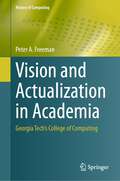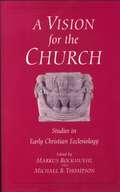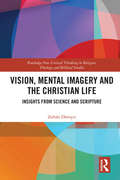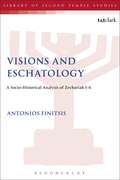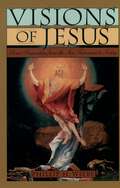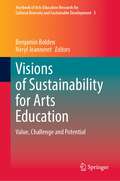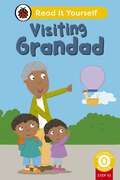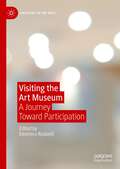- Table View
- List View
Visible Learning Guide to Student Achievement: Schools Edition
by John Hattie Eric M. AndermanVisible Learning Guide to Student Achievement critically examines the major influences shaping student achievement today. A revision of the International Guide to Student Achievement, this updated edition provides readers with a more accessible compendium of research summaries – with a particular focus on the school sector. As educators throughout the world seek to enhance learning, the information contained in this book provides practitioners and policymakers with relevant material and research-based instructional strategies that can be readily applied in classrooms and schools to maximize achievement. Rich in information and empirically supported research, it contains seven sections, each of which begins with an insightful synthesis of major findings and relevant updates from the literature since the publication of the first Guide. These are followed by key entries, all of which have been recently revised by the authors to reflect research developments. The sections conclude with user-friendly tables that succinctly identify the main influences on achievement and practical implications for educators. Written by world-renowned bestselling authors John Hattie and Eric M. Anderman, this book is an indispensable reference for any teacher, school leader and parent wanting to maximize learning in our schools.
Visible Learning Insights
by John Hattie Klaus ZiererVisible Learning Insights presents a fascinating ‘inside view’ of the ground-breaking research of John Hattie. Together, the authors John Hattie and Klaus Zierer embark on a mission to build on the internationally renowned work and combine the power and authority of the research with the real ‘coal face’ experience of schools. Offering a concise introduction into the ‘Visible Learning Story’, the book provides busy teachers with a guide to why the Visible Learning research is so vital and the difference it can make to learning outcomes. It includes: An in-depth dialogue between John Hattie and Klaus Zierer. Clearly structured chapters that focus on the core messages of ‘Visible Learning’ and infer practical consequences for the everyday job of teaching. FAQs to Visible Learning that provide an invaluable introduction to the language of learning and success in schools. An overview of the current data set with over 1,400 meta-analyses. Intended for teachers, teacher students, education researchers, parents, and all who are interested in successful learning, teaching, and schooling, this short and elegant introduction outlines just what is required to translate Hattie’s research into improved school performance.
Visible Learning into Action: International Case Studies of Impact
by John Hattie Deb Masters Kate BirchRecently at the Visible Learning Conference, Professor John Hattie stood up in his opening address and said, "I’m looking at you all and thinking ‘What if I got this wrong?’" I feel the same way when educators ask to visit and I always end up in the same place – that Keilor Views is a living, breathing example that he didn’t. -- Charles Branciforte, Principal of Keilor Views Primary School, Melbourne, Australia Visible Learning into Action takes the next step in the evolving Visible Learning story. It translates one of the biggest and most critically acclaimed education research projects ever undertaken into case studies of actual success stories, implementing John Hattie’s ideas in the classrooms of schools all around the world. The evidenced case studies presented in this book describe the Visible Learning journeys of fifteen schools from Australia, USA, Hong Kong, UK, Sweden, New Zealand and Norway and are representative of the VL international community of schools in their quest to ensure all of their students exceed their potential for academic success. Each school’s story will inform and inspire, bringing to life the discussions, actions and reflections from leaders, teachers, students and families. This book features extensive, interactive appendices containing study guide questions to encourage critical thinking, annotated endnotes with recommendations for further reading and links to YouTube and relevant websites. Drawing on the latest research into the major principles and strategies of learning, this essential resource is structured into five parts: Know thy impact; Effective feedback; Visible learners; Inspired and passionate teachers; The Visible Learning School. Visible Learning into Action is aimed at any student, teacher or parent requiring an up-to-date commentary on how research into human learning processes can inform our teaching and what goes on in our schools.
Visible Learning into Action: International Case Studies of Impact
by John Hattie Deb Masters Kate BirchRecently at the Visible Learning Conference, Professor John Hattie stood up in his opening address and said, "I’m looking at you all and thinking ‘What if I got this wrong?’" I feel the same way when educators ask to visit and I always end up in the same place – that Keilor Views is a living, breathing example that he didn’t. -- Charles Branciforte, Principal of Keilor Views Primary School, Melbourne, Australia Visible Learning into Action takes the next step in the evolving Visible Learning story. It translates one of the biggest and most critically acclaimed education research projects ever undertaken into case studies of actual success stories, implementing John Hattie’s ideas in the classrooms of schools all around the world. The evidenced case studies presented in this book describe the Visible Learning journeys of fifteen schools from Australia, USA, Hong Kong, UK, Sweden, New Zealand and Norway and are representative of the VL international community of schools in their quest to ensure all of their students exceed their potential for academic success. Each school’s story will inform and inspire, bringing to life the discussions, actions and reflections from leaders, teachers, students and families. This book features extensive, interactive appendices containing study guide questions to encourage critical thinking, annotated endnotes with recommendations for further reading and links to YouTube and relevant websites. Drawing on the latest research into the major principles and strategies of learning, this essential resource is structured into five parts: Know thy impact; Effective feedback; Visible learners; Inspired and passionate teachers; The Visible Learning School. Visible Learning into Action is aimed at any student, teacher or parent requiring an up-to-date commentary on how research into human learning processes can inform our teaching and what goes on in our schools.
Visible Maths: Using representations and structure to enhance mathematics teaching in schools
by Peter MattockPeter Mattock’s Visible Maths: Using representations and structure to enhance mathematics teaching in schools supports teachers in their use of concrete and pictorial representations to illustrate key mathematical ideas and operations.Viewing the maths lesson as an opportunity for pupils to develop a deep understanding of mathematical concepts and relationships, rather than simply to follow fixed processes that lead to ‘the answer’, is increasingly recognised as the pinnacle of best practice in maths education.In this book, Peter Mattock builds on this approach and explores – in colourful detail – a variety of visual tools and techniques that can be used in the classroom to deepen pupils’ understanding of mathematical operations. Covering vectors, number lines, algebra tiles, ordered-pair graphs and many other representations, Visible Maths equips teachers with the confidence and practical know-how to take their pupils’ learning to the next level.The book looks at the strengths, and flaws, of each representation so that both primary and secondary school teachers of maths can make informed judgements about which representations will benefit their pupils. The exploration begins at the very basics of number and operation, and extends all the way through to how the representations apply to algebraic expressions and manipulations. As well as sharing his expert knowledge on the subject, Peter draws on relevant research and his own experience of using the representations in order to support teachers in understanding how these representations can be implemented effectively.Visible Maths also includes a glossary covering the key mathematical terms, as well as a chapter dedicated to answering some of the questions that may arise from the reading of the book. Furthermore, the accompanying diagrams and models are displayed in full colour to illustrate the conceptual takeaways and teaching techniques discussed.Suitable for teachers of maths in primary and secondary school settings.Chapters include: 1. Different representations of whole numbers; 2. Representing fractions and decimals; 3. Addition and subtraction with integers; 4. Multiplication and division of integers; 5. Powers and roots; 6. Operations with fractions and decimals; 7. Laws of arithmetic; 8. Order of operations; 9. Accuracy and numerical representations; 10. Representing irrational numbers; 11. Introducing algebra; 12. Simplifying algebraic expressions; 13. Multiplying algebraic expressions; 14. Expanding and factorising algebraic expressions; 15. Equations and representations; 16. Further algebraic manipulations; 17. Frequently asked and anticipated questions.Customer notice: this book contains a large amount of full colour images, therefore any digital version would be better rendered by being viewed using a device with a colour display.
Vision and Actualization in Academia: Georgia Tech’s College of Computing (History of Computing)
by Peter A. FreemanAlthough difficult, change in academic structures is necessary today, especially in fast-changing fields today such as biology, computing, management, the social sciences, and others. This includes changes within existing organizations as well as creation of new structures and reorganizations or eliminations of older ones. This narrative attempts first to document the historical rise of an organization, Georgia Tech’s College of Computing, that has touched and successfully changed the lives of thousands of people. Second, it aims to identify and explicate some of what has led to this widely acknowledged success. The book provides a chronological narrative that highlights major changes taken under each successive leader. These changes have built on one another, knowingly or otherwise, to create a growing organization that rivals in size and prominence longer established parts of the university. The case study, while of an academic organization focused on computing, provides general lessons applicable almost anywhere. Topics and features: Discusses the nature and uses of visions, both general and specificShows how visions can be used to drive specific actions and resource allocationsIllustrates the choice and use of enduring organizational principlesOutlines a simple strategic-planning method and its applicationIndicates results of this overall approach This book will be of interest to anyone interested in organizational change, especially in academia, and to those interested in Georgia Tech. It will also appeal to policymakers in education, government, and industry; as well as anyone interested in the historical growth of the computing milieu broadly. Peter A. Freeman was Founding Dean and Professor in the College of Computing at Georgia Tech from 1990 to 2002. Today he is an Emeritus Dean and Professor.
A Vision for Science Education: Responding to Peter Fensham's Work
by Roger CrossOne of the most important and consistent voices in the reform of science education over the last thirty years has been that of Peter Fensham. His vision of a democratic and socially responsible science education for all has inspired change in schools and colleges throughout the world. Often moving against the tide, Fensham travelled the world to promote his radical ideology. He was appointed Australia's first Professor of Science Education, and was later made a Member of the Order of Australia in recognition of his work in this new and emerging field of study.In this unique book, leading science educators from around the world examine and discuss Fensham's key ideas. Each describes how his arguments, proposals and recommendations have affected their own practice, and extend and modify his message in light of current issues and trends in science education. The result is a vision for the future of science teaching internationally.Academics, researchers and practitioners in science education around the world will find this book a fascinating insight into the life and work of one of the foremost pioneers in science education. The book will also make inspiring reading for postgraduate students of science education.
A Vision for Science Education: Responding to Peter Fensham's Work
by Roger CrossOne of the most important and consistent voices in the reform of science education over the last thirty years has been that of Peter Fensham. His vision of a democratic and socially responsible science education for all has inspired change in schools and colleges throughout the world. Often moving against the tide, Fensham travelled the world to promote his radical ideology. He was appointed Australia's first Professor of Science Education, and was later made a Member of the Order of Australia in recognition of his work in this new and emerging field of study.In this unique book, leading science educators from around the world examine and discuss Fensham's key ideas. Each describes how his arguments, proposals and recommendations have affected their own practice, and extend and modify his message in light of current issues and trends in science education. The result is a vision for the future of science teaching internationally.Academics, researchers and practitioners in science education around the world will find this book a fascinating insight into the life and work of one of the foremost pioneers in science education. The book will also make inspiring reading for postgraduate students of science education.
Vision for the Church: Studies in Early Christian Ecclesiology
by Markus Bockmuehl Michael B. ThompsonWhat is the Church? Perhaps more importantly, what is it meant to be? How did its earliest members understand this body of which they had become a part? This is a textbook collection of fifteen essays by an international group of New Testament experts. They bring together a dynamic range of perspectives on how the early Christians viewed the Church: its origins, purpose and relation to Jewish Scriptures and to Jesus Christ; its place in the world and in God's plan; its community life and worship, in theory and in practice.
Vision, Mental Imagery and the Christian Life: Insights from Science and Scripture (Routledge New Critical Thinking in Religion, Theology and Biblical Studies)
by Zoltán DörnyeiThis book uniquely explores how the notion of vision is presented in modern science and the Bible, and how it can be applied to contemporary Christian contexts. The word "vision", our ability to see, has been described by an increasing body of scholarship in the social sciences as our capacity for mental imagery and imagination. As such, this unique cognitive capability has been utilised in many fields for a variety of purposes, from arts and psychotherapy to politics and business management, and even for performance enhancement in sports. The current book argues that a better understanding of vision can have far-reaching practical implications for Christian life and ministry by helping people to align themselves with God’s specific purposes. After a theoretical overview that integrates scientific and theological insights, the final chapters present a variety of strategies that can help believers to discern God’s call through the use of mental imagery and then to develop and cultivate the perceived vision. The book examines the scientific and biblical principles of vision in a comprehensive manner, with a special emphasis on the practical implications of the issue. As such, it will be of great interest to scholars of Theology, Biblical Studies and Church Growth/Leadership, as well as Organisational Behaviour, Business Management and Psychology.
Vision, Mental Imagery and the Christian Life: Insights from Science and Scripture (Routledge New Critical Thinking in Religion, Theology and Biblical Studies)
by Zoltán DörnyeiThis book uniquely explores how the notion of vision is presented in modern science and the Bible, and how it can be applied to contemporary Christian contexts. The word "vision", our ability to see, has been described by an increasing body of scholarship in the social sciences as our capacity for mental imagery and imagination. As such, this unique cognitive capability has been utilised in many fields for a variety of purposes, from arts and psychotherapy to politics and business management, and even for performance enhancement in sports. The current book argues that a better understanding of vision can have far-reaching practical implications for Christian life and ministry by helping people to align themselves with God’s specific purposes. After a theoretical overview that integrates scientific and theological insights, the final chapters present a variety of strategies that can help believers to discern God’s call through the use of mental imagery and then to develop and cultivate the perceived vision. The book examines the scientific and biblical principles of vision in a comprehensive manner, with a special emphasis on the practical implications of the issue. As such, it will be of great interest to scholars of Theology, Biblical Studies and Church Growth/Leadership, as well as Organisational Behaviour, Business Management and Psychology.
Vision of a School: The Good School in the Good Society
by Jasper Ungoed-ThoArguing that a good school is one with recognizable moral and intellectual traits, the author outlines his view of how schools should be organized, as a whole and in every field of education, to encourage these traits.
Vision, Reading Difficulties, and Visual Stress
by Bruce J. Evans Arnold J. WilkinsThis book provides an overview of the research surrounding the relevance of visual factors for those who struggle with reading. Visual interventions that have been advocated as helping with reading include spectacles that simply correct refractive errors (e.g., long-sightedness), coloured overlays (sheets placed on the page) and coloured lenses, vision therapy, and computer games. This book explains the rationale behind these interventions and discusses the evidence supporting them. Clear advice is given in plain English to those wondering if these interventions will be helpful.Vision, Reading Difficulties, and Visual Stress, 2nd Edition draws together disparate research findings in a range of neurological disorders where vision is compromised by cortical hyperexcitability. Optometrists, orthoptists, ophthalmologists, educational psychologists, teachers, and vision scientists will find this book to be an interesting resource as well as students in these disciplines and parents of children who struggle with reading.
Visionary Women and Visible Children, England 1900-1920: Childhood and the Women's Movement
by Berry MayallThis book addresses the inter-linked lives and fortunes of children and women in the first two decades of the twentieth century in England. This was a time of shifts in thinking and practice about children’s and women’s status, lived lives and experiences. The book provides a detailed explanation of how children experienced home, neighbourhood and elementary school; as well as discussing the impact of the women’s movement, namely its suffrage and socialist work. These two concerns are linked by the work women did about and for children. Essentially, the book explores childhood and womanhood; generation and gender; and socialism and feminism. Using existing studies on women’s work, and autobiographies and interviews about childhood, Mayall argues that women played a large part in re-thinking childhood as a special period in life, and children as participants in learning and in politics. This book will appeal to students and researchers in the fields of history, education and sociology, particularly those interested in the women’s movement, and the history of childhood.
Visionary Women and Visible Children, England 1900-1920: Childhood and the Women's Movement
by Berry MayallThis book addresses the inter-linked lives and fortunes of children and women in the first two decades of the twentieth century in England. This was a time of shifts in thinking and practice about children’s and women’s status, lived lives and experiences. The book provides a detailed explanation of how children experienced home, neighbourhood and elementary school; as well as discussing the impact of the women’s movement, namely its suffrage and socialist work. These two concerns are linked by the work women did about and for children. Essentially, the book explores childhood and womanhood; generation and gender; and socialism and feminism. Using existing studies on women’s work, and autobiographies and interviews about childhood, Mayall argues that women played a large part in re-thinking childhood as a special period in life, and children as participants in learning and in politics. This book will appeal to students and researchers in the fields of history, education and sociology, particularly those interested in the women’s movement, and the history of childhood.
Visioning and Engineering the Knowledge Society - A Web Science Perspective: Second World Summit on the Knowledge Society, WSKS 2009, Chania, Crete, Greece, September 16-18, 2009. Proceedings (Lecture Notes in Computer Science #5736)
by Miltiadis D. Lytras Ernesto Damiani John M. Carroll Robert D. Tennyson David Avison Ambjö Naeve Adrian Dale Paul Lefrere Felix Tan Janice Sipior Gottfried VossenIt is a great pleasure to share with you the Springer LNCS proceedings of the Second World Summit on the Knowledge Society, WSKS 2009, organized by the Open - search Society, Ngo, http://www.open-knowledge-society.org, and held in Samaria Hotel, in the beautiful city of Chania in Crete, Greece, September 16–18, 2009. The 2nd World Summit on the Knowledge Society (WSKS 2009) was an inter- tional scientific event devoted to promoting dialogue on the main aspects of the knowledge society towards a better world for all. The multidimensional economic and social crisis of the last couple of years has brought to the fore the need to discuss in depth new policies and strategies for a human centric developmental processes in the global context. This annual summit brings together key stakeholders involved in the worldwide development of the knowledge society, from academia, industry, and government, including policy makers and active citizens, to look at the impact and prospects of - formation technology, and the knowledge-based era it is creating, on key facets of l- ing, working, learning, innovating, and collaborating in today’s hyper-complex world. The summit provides a distinct, unique forum for cross-disciplinary fertilization of research, favoring the dissemination of research on new scientific ideas relevant to - ternational research agendas such as the EU (FP7), OECD, or UNESCO. We focus on the key aspects of a new sustainable deal for a bold response to the multidimensional crisis of our times.
Visioning Multicultural Education: Past, Present, Future
by H. Prentice BaptisteOrganized by the National Association of Multicultural Education (NAME), this volume explores the organic relationship between the past, present, and future of the discipline. In particular, the book addresses the various forms of recent social upheaval, from educational inequities and growing economic divides to extreme ideological differences and immigration conflicts. Written by a group of eminent and emerging scholars, chapters draw lessons from the past two decades and celebrate present accomplishments in order to ambition a better future through multicultural education.
Visioning Multicultural Education: Past, Present, Future
by H. Prentice Baptiste Jeanette Haynes WriterOrganized by the National Association of Multicultural Education (NAME), this volume explores the organic relationship between the past, present, and future of the discipline. In particular, the book addresses the various forms of recent social upheaval, from educational inequities and growing economic divides to extreme ideological differences and immigration conflicts. Written by a group of eminent and emerging scholars, chapters draw lessons from the past two decades and celebrate present accomplishments in order to ambition a better future through multicultural education.
Visions and Concepts for Education 4.0: Proceedings of the 9th International Conference on Interactive Collaborative and Blended Learning (ICBL2020) (Advances in Intelligent Systems and Computing #1314)
by Michael E. Auer Dan CenteaThis book contains papers in the fields of Interactive, Collaborative, and Blended Learning; Technology-Supported Learning; Education 4.0; Pedagogical and Psychological Issues. With growing calls for affordable and quality education worldwide, we are currently witnessing a significant transformation in the development of post-secondary education and pedagogical practices. Higher education is undergoing innovative transformations to respond to our urgent needs. The change is hastened by the global pandemic that is currently underway. The 9th International Conference on Interactive, Collaborative, and Blended Learning: Visions and Concepts for Education 4.0 was conducted in an online format at McMaster University, Canada, from 14th to 15th October 2020, to deliberate and share the innovations and strategies. This conference’s main objectives were to discuss guidelines and new concepts for engineering education in higher education institutions, including emerging technologies in learning; to debate new conference format in worldwide pandemic and post-pandemic conditions; and to discuss new technology-based tools and resources that drive the education in non-traditional ways such as Education 4.0. Since its beginning in 2007, this conference is devoted to new learning approaches with a focus on applications and experiences in the fields of interactive, collaborative, and blended learning and related new technologies. Currently, the ICBL conferences are forums to exchange recent trends, research findings, and disseminate practical experiences in collaborative and blended learning, and engineering pedagogy. The conference bridges the gap between ‘pure’ scientific research and the everyday work of educators. Interested readership includes policymakers, academics, educators, researchers in pedagogy and learning theory, school teachers, industry-centric educators, continuing education practitioners, etc.
Visions and Eschatology: A Socio-Historical Analysis of Zechariah 1-6 (The Library of Second Temple Studies #79)
by Antonios FinitsisZechariah 1-6 is unlike most of the prophets in the Hebrew Bible. He is pro-establishment and he conveys his message mostly with visions. These observations have led to scholarly disagreements as to how one should understand his role. Antonios Finitsis mediates this disagreement by triangulating the relationship of Zechariah's visionary mode of expression, his message and his function. Zechariah has often been seen as a link between prophecy and apocalypticism. However, Finitsis argues again assuming the presence of this link - warning against the potential for reductionist thinking. Furthermore, Proto-Zechariah's viewpoint is particular to the post-exilic social setting. His visions are influenced by the social circumstances in which they are expressed. Proto-Zechariah refers to the near future using elements from the community's present. Therefore, Finitsis defines the message of Proto-Zechariah one of restoration eschatology, suggesting that the text is addressed to a small province plagued by inner-community conflicts. The text succeeds in alleviating social discord by empowering the people to rebuild their community. This presents a unique and challenging understand of Zechariah's prophetic role.
Visions for Intercultural Music Teacher Education (Landscapes: the Arts, Aesthetics, and Education #26)
by Heidi Westerlund Sidsel Karlsen Heidi ParttiThis open access book highlights the importance of visions of alternative futures in music teacher education in a time of increasing societal complexity due to increased diversity. There are policies at every level to counter prejudice, increase opportunities, reduce inequalities, stimulate change in educational systems, and prevent and counter polarization. Foregrounding the intimate connections between music, society and education, this book suggests ways that music teacher education might be an arena for the reflexive contestation of traditions, hierarchies, practices and structures. The visions for intercultural music teacher education offered in this book arise from a variety of practical projects, intercultural collaborations, and cross-national work conducted in music teacher education. The chapters open up new horizons for understanding the tension-fields and possible discomfort that music teacher educators face when becoming change agents. They highlight the importance of collaborations, resilience and perseverance when enacting visions on the program level of higher education institutions, and the need for change in re-imagining music teacher education programs.
Visions of Jesus: Direct Encounters from the New Testament to Today
by Phillip H. WiebeErnie Hollands, a career criminal, said Christ appeared to him in his cell in Millhaven Penitentiary. Maria Martinez saw Jesus at a busy intersection in Miami, Florida. Rose Fairs was lying in bed one morning when the Venetian blinds opened and the head of Jesus materialized before her. Were these people only imagining a figure that seemed life-like, or is there a chance that what they saw was, in some way, real? This first critical study of contemporary visions of Jesus offers the intriguing accounts of thirty people, most of them ordinary men and women without prior or subsequent experiences of this kind, who remain mystified about their encounters. Wiebe recounts each vision in vivid detail, exploring why these individuals believe their visions were of Jesus, and why they typically believe them to be objective happenings, rather than hallucinations or dreams. He regards the occurrences from perspectives as diverse as biblical scholarship and parapsychology, concluding that they may well represent genuine religious experiences of a mystical character. The fascinating nature of these visions and Wiebe's thoughtful, evenhanded approach to each report add up to a book that will be provocative reading for skeptics and the faithful alike.
Visions of Sustainability for Arts Education: Value, Challenge and Potential (Yearbook of Arts Education Research for Cultural Diversity and Sustainable Development #3)
by Benjamin Bolden Neryl JeanneretThis book stems from the 2019 meeting of the UNESCO UNITWIN international network for Arts Education Research for Cultural Diversity and Sustainable Development. It presents scholarly, international perspectives on issues surrounding arts education and sustainability that addresses the following questions: What value can the arts add to the education of citizens of the 21st century?; What are the challenges and ways forward to realize the potential of arts education in diverse contexts? The book discusses empirical research and exemplary practices in the arts and arts education around the world, presenting sound theoretical and methodological frames and approaches. It identifies policy implications at national, regional and global levels that cut across social, economic, environmental and cultural dimensions of sustainable development.
Visiting Grandad (Read It Yourself)
by LadybirdTwo stories that build on the phonics learned in previous steps and practise sound and letter combinations that have already been encountered.Visiting Grandad is from Beginner Reader Level 0 and is ideal for children aged from 4+ who are developing their phonics and early reading skills.Each book has been carefully checked by educational and subject consultants and includes comprehension puzzles, book band information, and tips for helping children with their reading.With five levels to take children from first phonics to fluent reading and a wide range of different stories and topics for every interest, Read It Yourself helps children build their confidence and begin reading for pleasure.
Visiting the Art Museum: A Journey Toward Participation (Sociology of the Arts)
by Eleonora RedaelliVisiting the Art Museum: A Journey Toward Participation is a book about the visitor experience. It is written as a companion for visitors to and inside the art museum. The volume engages readers in transforming a common experience, the museum visit, into a sophisticated epistemological inquiry. The study of the visitor experience through an epistemological approach consists of the untangling of the academic disciplines that study and inform each step of this experience: urban studies, architecture, design, art history, art education, and nonprofit management. This journey follows a transformative bottom-up trajectory from experiential to epistemological, and, finally, reveals itself as empowering. The book unfolds as an edited volume, with chapters by different authors who are enthusiastic scholars in each discipline and addresses undergraduate students as citizens, master’s students as professionals, and scholars as teachers and researchers. Each reader will discover a kaleidoscopic world made of ideas, values, and possibilities for participation.




